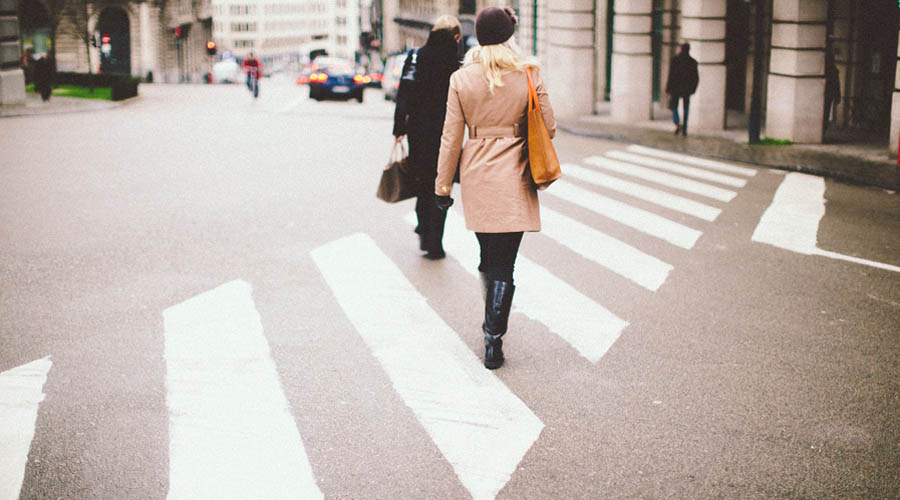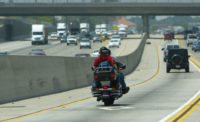A FairWarning story
Smartphone distractions, drinking help spur rising pedestrian death toll

Pedestrian deaths are surging across the nation, and analysts are putting much of the blame on drivers and walkers who are looking at their smartphones instead of watching where they are going. Tipsy walking also is part of the problem, with one in three victims legally drunk when they were struck and killed.
The latest report on U.S. pedestrian deaths, from the Governors Highway Safety Association, estimates that last year’s total rose 11.6 percent to nearly 6,000, or more than 16 fatalities a day. If that projection proves accurate – it is based on a fatality records from only the first half of 2016 – it would mark the sharpest yearlong increase since federal officials began keeping such statistics in the mid-1970s. What’s more, it follows a big increase of 9.5 percent in 2015, and is outpacing the overall rise in traffic deaths.
The study said other reasons for the spike might be more people walking for their health and an upsurge in vehicular traffic. Yet it emphasized that skyrocketing smartphone use and messaging as “a frequent source of mental and visual distraction for both walkers and drivers.”
Richard Retting, a transportation consultant who authored the report, noted the danger created when a driver glances down at a phone for just three seconds. During that short glance, a driver motoring at a typical city speed of 30 miles per hour would travel 132 feet. “That’s a lot of opportunity to strike a pedestrian,” he said in an email to FairWarning.
Retting added that “intoxication has been a persistent risk factor for decades. “With several states legalizing or considering legalizing marijuana, there may be growing concerns related to both drugs and alcohol impairment.”
The report estimated that 15 percent of drivers involved in deadly crashes with pedestrians were legally drunk, along with finding that one-third of pedestrians killed were intoxicated.
Little government investment
In 2015, the U.S. Government Accountability Office reported that safety efforts for pedestrians, as well as for bicyclists, were hindered by streets that were generally designed “to move motor vehicles… as expeditiously as possible.” Retting made a similar point, and cited “long spacing between signalized intersections on many of the nation’s major arterial roadways.”
As FairWarning has reported, there generally has been little government investment in safety measures to protect pedestrians or bicyclists. But last year several states launched new road engineering or public awareness programs to improve safety, according to the governors’ report. For example, in Rexburg, Idaho, city officials have taken a particularly tough action, banning texting or other cell phone use by people crossing streets. Violations carry a $50 fine for the first offense and $150 for subsequent convictions.
And in one ironic twist, Delaware and Oregon said they are using social media, including Facebook, to urge motorists and walkers to avoid engaging in social media when they should be focusing on traffic.
The new projection anticipates that pedestrian deaths will account for about 15 percent of all motor vehicle-related fatalities. But that percentage, along with the overall number of pedestrian fatalities, remains lower than in the mid-1970s, when annual pedestrian death tolls exceeded 7,500.
The official pedestrian fatality estimate for 2016 is due to be released by the U.S. Department of Transportation late this year.
About FairWarning
This story was reported by FairWarning (www.fairwarning.org), a nonprofit news organization based in Pasadena, Calif., that focuses on public health, safety and environmental issues.
Looking for a reprint of this article?
From high-res PDFs to custom plaques, order your copy today!
 Paul Feldman is a staff writer for FairWarning. Paul worked as a staff writer and editor at the Los Angeles Times for more than 30 years. He was a reporter on the Metro staff, and later a Metro desk editor, overseeing coverage of the environment, legal affairs and other topics. From 2003 through 2015, he served as an assistant foreign editor, working with a team of foreign correspondents on breaking news and features. He was a member of Metro teams that won two Pulitzer Prizes and two American Bar Assn. Silver Gavel awards. He also won the gold medal in a ping pong tournament on a Royal Caribbean cruise to Alaska.
Paul Feldman is a staff writer for FairWarning. Paul worked as a staff writer and editor at the Los Angeles Times for more than 30 years. He was a reporter on the Metro staff, and later a Metro desk editor, overseeing coverage of the environment, legal affairs and other topics. From 2003 through 2015, he served as an assistant foreign editor, working with a team of foreign correspondents on breaking news and features. He was a member of Metro teams that won two Pulitzer Prizes and two American Bar Assn. Silver Gavel awards. He also won the gold medal in a ping pong tournament on a Royal Caribbean cruise to Alaska. 



